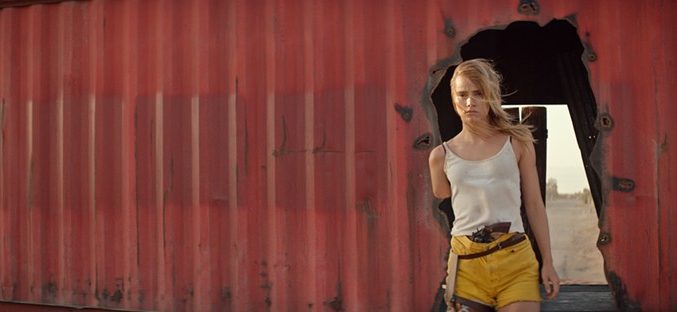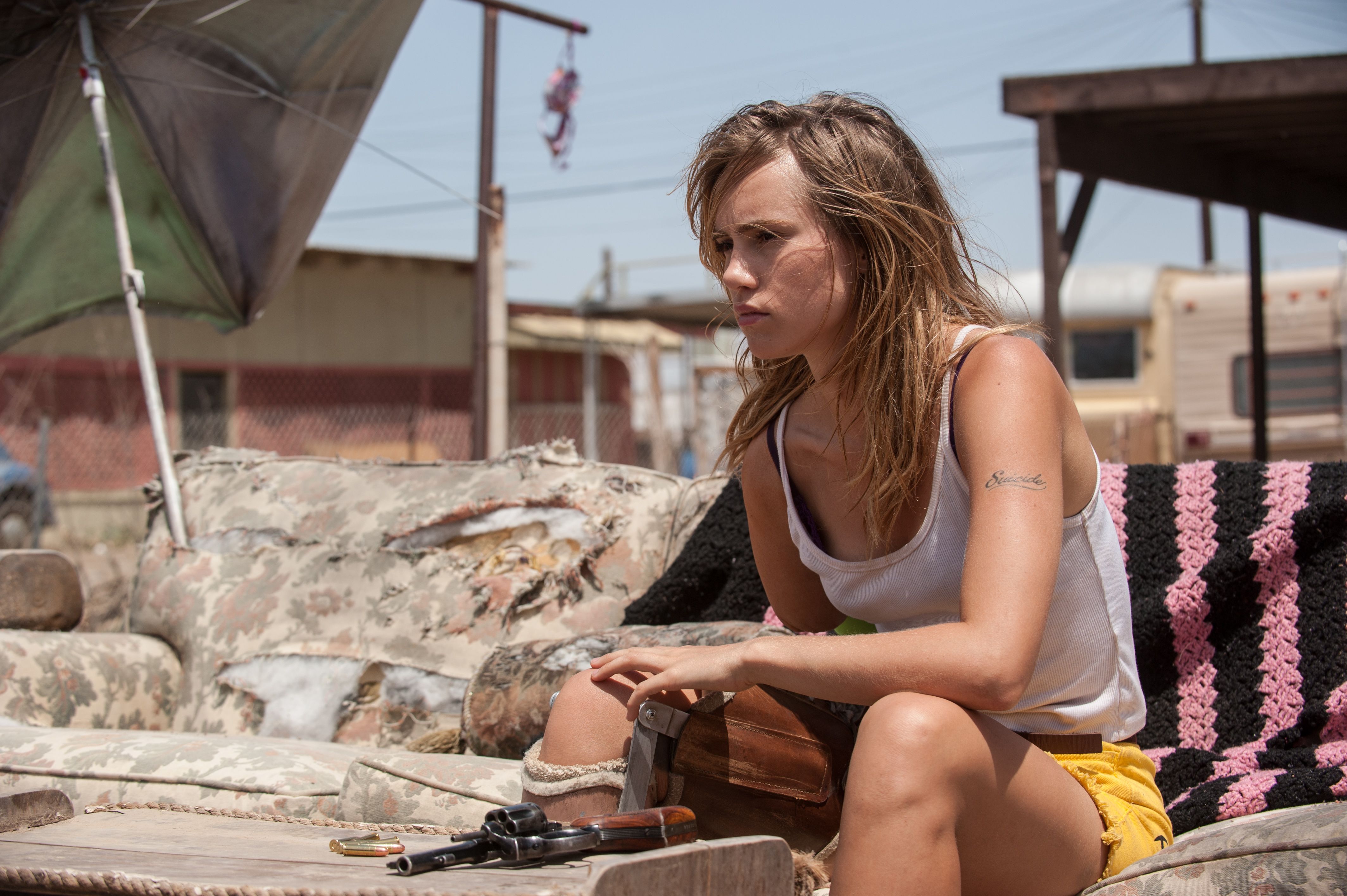Even when Ana Lily Amirpour paints the desert with LSD trip-lights and grindhouse theater, the empty lands of The Bad Batch show through like scabbing wounds. Her second feature’s stylistic hallmarks are consistent with those of her first, A Girl Walks Home Alone At Night: few words, skateboard transit, slow-paced hyperviolence, dance music employed with intention. Amirpour’s kept her team intact with cinematographer Lee Vincent and editor Alex O’Flinn. Together they bring the emotional currency from their Iranian vampire Western debut to a wildly different world. And it’s a much better-funded world this time, under co-producers Annapurna Pictures and VICE Films, which distributed the 2014 movie.
Amirpour led viewers to the core of A Girl with a young woman protagonist who murders a dangerous character early in the film and struggles with her own capacity for violence, alongside a romantic interest who’s close to the one she felled. That mysterious “girl in the chador” (Shiela Vand) walks into full sun to become Arlen in The Bad Batch. The Texan teen, played by a sneering and lithesome Suki Waterhouse, loses an arm and a leg to a gang of cannibals. The saw grinds her arm as Ace Of Base’s “All That She Wants” plays on a stereo. Arlen moans. A woman standing by looks at first as if she’s about to step on her face to keep her quiet. Instead, she turns the volume up.
Arlen writhes in a close-up, in sync with the song almost as if dancing; blood spatters onto her face. It’s exactly the kind of risky double-edge Amirpour is so deft at wielding. With this one scene, Amirpour protects a complicated space of bonded empathy in dance music culture, something that makes her truly distinct as a director who privileges the craft of a soundtrack. In the crowdfunded A Girl, work by more obscure artists like Dallas’ Farah get this treatment. There is no denial of pain in this film – attempts to blunt the hurt only serve to express its relentlessness. Few filmmakers can use pop music diagetically to elevate a movie. Amirpour’s increased access to the trove is one to celebrate.
Her increased profile is not to be idealized, though. The film helps remind us of this. We see Arlen put scissors into a picture of a naked woman in a magazine, looking admiringly at her body; in the next frame the cutout is taped to the mirror. It’s only an arm. Arlen moves back to scale herself to the appendage, making herself whole. It’s the first nod to an iconic mirror sequence in A Girl, moving the audience into Arlen’s range of desire. The girl in the chador rode a skateboard through the streets of Bad City; Arlen scoots herself along across the sand with one under her back toward a place called Comfort.

Terrain may be wider in Comfort, its vastness suggesting that of West Texas (though the movie was filmed mostly in Los Angeles.) The young woman’s limits in moving through it, through, antagonize her surroundings. Life is fraught with danger – the tradeoff for a lawless state of Comfort. All Arlen wants is to be useful, to “be the solution to something.”
What Amirpour does with the money in The Bad Batch smirks directly at pressure that comes with an increase of resources. Jim Carrey, who plays a kind hobo wearing Air Jordans the actor requested for the character, has no lines. Keanu Reeves appears as a ’70s-styled druglord cult leader flanked by smiling pregnant brunettes—“The Dream”—who beckons with his palace as the safest place to be. Like in another dystopian sophomore feature out now, Trey Edward Schultz’s It Comes At Night, new promises of safety are constantly eroding. That film draws audiences into an almost unbearably dark world with suspense. The Bad Batch uses a carnie sense of humor as its carrot through grating light, where nothing is hidden but it’s still as scary.
Moral judgment changes with the stakes of life and death. In The Bad Batch, this manifests in a constant threat of being eaten, sending Arlen, gun in the back of her yellow smiley-face-patterned cutoffs, to blow away the wife of Miami Man (Jason Momoa), who leads the pack that made Arlen an amputee. Someone’s watching, though. The couple’s young daughter, Honey. Arlen takes her along. Honey lines the teen’s eyes in the mirror, the little girl’s beloved rabbit at their feet. Eventually Arlen loses track of Honey, transported by an LSD trip at a Comfort-wide party. She’ll spend the rest of the film trying to find her, but in this frozen moment, tiny green lights dance on Arlen’s face, scoring an inner dialogue that reassures her the girl is safe.
This audio-visual is one Amirpour shared with Waterhouse before they began shooting the film, the actress said in a Q&A livestreamed by Alamo Drafthouse on Sunday at an early screening. The two women listened to music Amirpour had on reserve for the movie, and the director put those lights on her face so she could feel the heart of what Amirpour was after in The Bad Batch. It’s the same heart we came to know in her debut. With the recognizable use of landscapes and clothes and sounds in Amirpour’s second film, there’s also the voice of the director, which promises to become even more familiar.





